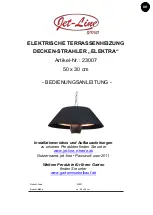
6
Installation
setting of the relief valve, causing it to operate
during each heating cycle. Thermal expansion, and
the resulting rapid, repeated expansion and contrac-
tion of components in the water heater and piping
system can cause premature failure of the relief
valve and possibly the heater itself. Replacing the
relief valve will not correct the problem!
The suggested method of controlling thermal
expansion is to install an expansion tank in the cold
water line between the water heater and the check
valve. The expansion tank is designed with an air
cushion built in that compresses as the system
pressure increases, thereby relieving the over pres-
sure condition and eliminating the repeated operation
of the relief valve. Other methods of controlling ther-
mal expansion are also available. Contact your install-
ing contractor, water supplier, or plumbing inspector
for additional information regarding this subject.
If a recirculation line is installed, the return con-
nection should be made through a tee close to the
inlet connection on the water heater. A check valve
should always be installed in the recirculation line to
prevent cold water from entering.
WATER CONNECTIONS — This water heater may be
connected individually, in multiples with others, or
with an external hot water storage tank.
Inlet water connections are made to the lower
coupling on the heater, and outlet water connections
are made to the upper coupling.
Each water heater is supplied with the necessary
components (diffuser tubes) to make the water
connections that will ensure proper performance.
The components are supplied in a bag attached to
the water heater. If special instructions are required
for any specific water heater, they will be included in
the bag.
Cap or plug unused connections. Use only clean,
new galvanized steel, copper or approved plastic
pipe for water connections. Local codes or regula-
tions shall govern the exact type of material to be
used.
The installation of unions on the inlet and outlet
water lines and a shut-off valve in at least the cold
water inlet line is recommended, so the water heater
may be easily disconnected for servicing. Dielectric
unions are not required for protection of the water
heater.
Mixing valves are recommended for reducing point
of use water temperature by mixing hot and cold
water in branch water lines. It is recommended
that a mixing valve complying with the Standard for
Temperature Actuated Mixing Valves for Hot Water
Distribution Systems, ASSE 1017 be installed. See
page 3 for more details and contact a licensed
plumber or the local plumbing authority for further
information.
Thermometer(s) should be installed so that they
indicate the temperature of the water at or near the
outlet of the water heater and storage tank(s) if
provided. See Fig. 2.
3. RELIEF VALVE — A new factory installed combina-
tion pressure and temperature relief valve, comply-
ing with the Standard for Relief Valves and Auto-
matic Gas Shutoff Devices for Hot Water Supply
Systems, ANSI Z21.22, or Standard CSA 4.4, Tem-
perature, Pressure, Temperature and Pressure Relief
Valves and Vacuum Relief Valves is provided with the
water heater. No valve is to be placed between the
relief valve and the water heater. For a circulating
tank installation, the separate storage tank(s) must
have similar
protection. The pressure rating of the relief valve
must not exceed 150 psi (1034 kPa) (160 psi for
ASME models), the maximum working pressure as
marked on the front of the water heater.
Connect the outlet of the relief valve to a suitable open drain.
The discharge line must pitch downward from the valve to
allow complete draining (by gravity) of the relief valve and
discharge line, and be no smaller than the outlet of the valve.
The end of the discharge line should not be threaded or
concealed and should be protected from freezing. No
valve of any type, restriction or reducer coupling should be
installed in the discharge line. Local codes shall govern the
installation of relief valves.
The Btu/h rating of the relief valve must equal or
exceed the Btu/h input of the water heater as
marked on its rating plate.
4. GAS SUPPLY — The inlet gas pressure to the water
heater must not exceed 10.5" wc (2.6 kPa) for
Natural gas and 13.0" wc (3.2 kPa) for L.P. gas. The
minimum inlet gas pressure (with main burner on)
is shown on the rating plate. Check to see if high
or low gas pressure is present and then contact the
gas company for correction.
The gas line should be of adequate size to prevent
undue pressure drop (pressure should not drop more
than 1.5", when going from standby to full blower
speed condition). Sizing based upon information in
Table 2, on page 24. No additional allowance is nec-
essary for an ordinary number of fittings.
NOTE: The minimum inlet gas pressure (at gas
valve), during ignition to full input, should not be
less than 3.5" WC for Nat. or 11" WC for LP.
A ground joint union and manual shutoff valve
should be installed in the gas line near the water
heater so that the burner assembly may be easily
removed. The shut-off valve must be readily acces-
sible for turning on or off. See Fig. 2.
If a sediment trap is not incorporated as part of the
appliance, a sediment trap shall be installed down-
stream of the equipment shutoff valve as close to
the inlet of the appliance as practical at the time of
the appliance installation. The sediment trap shall be
either a tee fitting with a capped nipple in the
bottom outlet or other device recognized as an
effective sediment trap. See Fig. 2.
LEAK TESTING — The water heater and its gas
connections MUST be leak tested at normal operat-
ing pressure before it is placed in operation. Turn ON
WARNING
!







































